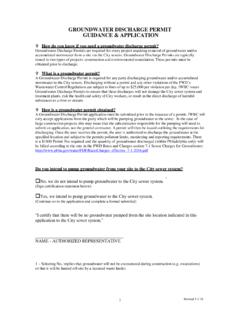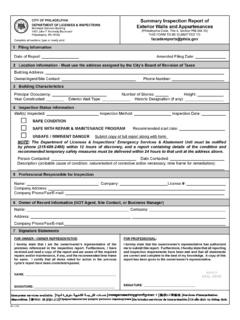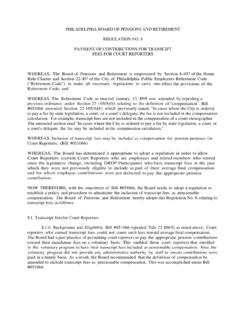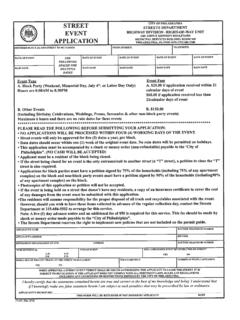Transcription of Property Assessment Methodology - phila.gov
1 Office of Property Assessment April 2013 Property Assessment Methodology 1 Introduction This presentation will describe the key steps and processes taken by the Office of Property Assessment to estimate real Property values for tax purposes for single family residential properties Mass appraisal analysis begins with assigning properties to use classes based on highest and best use, which normally equates to current use. Some statutes require that Property be valued for ad valorem tax purposes at current use regardless of highest and best use. Zoning and other land use controls normally dictate highest and best use of vacant land. Mass appraisal uses a model, that is, an equation that represents the relationship between value and variables representing factors of supply and demand. Mass appraisal models attempt to represent the market for a specific type of Property in a specified area. Valuation models are developed for defined Property groups. For residential properties, geographic stratification (dividing of geographic areas) is appropriate when the value of Property attributes varies significantly among areas and each area is large enough to provide adequate sales.
2 It is particularly effective when housing types and styles are relatively uniform within areas. Separate models are developed for each market area (also known as economic or model areas). To model residential parcels, the OPA used several years of sales data and data related to the physical characteristics of the parcels to estimate value using a comparable sales approach 2 Sales Validation The first step in the process was to validate sales, to make sure that the sales data in the model reflects sales that are good indicators of the value of similar properties. Sales were validated by OPA staff for the analysis period from Jan. 2006 Jun. 2012. Only valid, arms-length transactions were used. In many cases, properties change significantly between the time that they were sold and the time that they are valued. Characteristics or attributes that are key contributors to value are captured as of the date of the transaction. In this way, a Property that was sold as vacant land, but has subsequently had a dwelling erected, will be treated as a land sale, and not the sale of a residence, for modeling purposes.
3 That same Property will be valued based on what it is as of the date of appraisal. The data was validated by removing the following from the data set: Blanket transactions Speculator purchases Sales between related parties Partial interests Bids, foreclosures or sales with no, or atypical, financing Sales where the Property characteristics significantly changed from the time of sale than at the time of valuation (for example, if a Property was rehabilitated or demolished) Sales of extremely unusual properties Sales reported from the Department of Records that used OPA data to determine a value for Transfer Tax purposes when the original sales price was not reflective of market value or was a nominal value, such as a $1. 3 Development of Sub-Markets or Zones Prior to selecting comparable properties, the relevant sub-market must be defined which is a set of properties that would be considered alternates in the mind of the typical buyer of such Property . Based on the number of sub-markets in Philadelphia (which can vary as far as land values, economic conditions, and preferences for various attributes, such as access to employment, shopping or entertainment), the OPA built 14 geographic models for single family homes.
4 Variables were entered and tested in a statistical analysis called backwards regression to determine if the market(s) recognized premiums ( characteristics that would result in higher values) or penalties (attributes that would result in lower values). As there are non-linear relationships in the contributory value of certain variables, the OPA used logs or exponents for their coefficients. The models are designed to maximize uniformity as measured in the Assessment industry, and to produce a desirable degree of accuracy in the estimates of value for a specific point in time. 4 Geographic Market Areas As part of the process for determining Property values, the OPA also reviewed sales data to identify pockets of real estate activity where similar properties were selling for similar prices. Drawn to the parcel level, these pockets are called Geographic Market Areas (GMAs) and are even more specific than sub-markets or neighborhood breakdowns. The OPA broke the city into approximately 650 GMAs.
5 Each parcel lies within a GMA and is assigned to the correct GMA through a map-based GIS process. The GMA boundaries are reviewed and changed to maximize the integrity of the location variables. This process is not based on formulae or calculation. For the OPA s models, each GMA is transformed into a binary variable. 5 Field Inspections Properties were field inspected to update OPA s records and to give evaluators a high degree of certainty that the Property will be valued based on its current characteristics. For AVI, 100% of the accounts were inspected. In future years, OPA will determine which properties will be inspected. These inspections allowed the evaluators to collect data on characteristics of properties throughout the city, as well as using other tools at their disposal, such as permit information from the Department of Licenses and Inspections and private Property listings that described other characteristics. 6 Variables Used Along with location in the GMAs, other attributes that have an effect on sales price are included in each model.
6 Physical characteristics that were used in the model included: Property type Building square footage Garage Garage spaces Off street parking (in those neighborhoods where this was deemed to be valuable, such as center city) Interior condition (or presumed interior condition) Era built (relative age) View amenity Lot size Central air conditioning 7 Time Adjustments During the sales analysis period (2006-2012), the city was at the tail end of a booming housing market, followed by a precipitous decline in many, but not all, areas. This rise, and subsequent fall, did not conform to a single index. Through regression, the OPA built a compound adjustment index for each model that allowed them to calibrate a sale from any given month in the sales analysis period to the effective date of appraisal. By adjusting each sale for time, the OPA was able to remove the time adjustment variables from the final iteration of the model. A sale price from a high point in the market would therefore be adjusted downwards to the equivalent in today s prices, while a sale from a low point in the market would be adjusted upwards.
7 Since every sale is adjusted for time, there is no need to weight sales based on the time that they transacted. The OPA did not use the more common Methodology of using a straight line time adjustment, because neither the direction (up/down) nor the slope (degree of change) was constant over the analysis period. Instead, the OPA used a splined time adjustment technique, allowing them to capture fluctuations in the market. 8 Defining a typical Property within the GMA 9 Each model defines a base or typical Property , and calculates the value of every degree of difference from the base Property . Adjustments are made as percentage multipliers or based on logarithmic scales for attributes like building or lot square footage. The regression models begin by considering all attributes entered, removing the least most significant variable one at a time, until all that remains are the variables that contribute significantly to sale price. In this way every model will develop a unique set of base values, adjustment coefficients and time adjustments.
8 Properties that did not sell are matched to the appropriate model. Each Property is valued like the base Property , and a series of compound multipliers are applied to that (base) value in conformance to the adjustment coefficients for that model. There is no one formula that is used. Sales Review Sales that were validated are reviewed a second time, along with any new transactions that have been reported during the field inspection period. This second review reflects any changes in the GMAs as well to other Property data elements based on field inspections. The end result is a file of thousands of sales that are considered by the professional evaluation staff to be good, reliable indicators of value for similar properties. 10 Determining land value The OPA s market value models project an estimated sales price for each parcel. To determine the allocation of land and building assessments, the OPA used the assistance of an outside expert, Dr. Kevin Gillen. Dr.
9 Gillen has been analyzing land value in the region for many years, and had access to data that the OPA did not have. The OPA then subtracted Dr. Gillen s land values from the total market value to determine the allocation of the building Assessment . 11 Projecting Values from the Coefficients File Each model produced a base value and a set of adjustment coefficients In order to project values, the OPA uses two processes: SPSS (a statistical modeling system), the OPA verifies the mathematical accuracy of the projections by measuring the projections against known sales prices. staff is satisfied that the values are projecting properly, they match each account against the coefficients file to calculate the market value. Programming staff has created a script that performs the same calculations in the Property databases The OPA compares both methods to assure the accuracy of the projections 12 Review by Evaluators All market value projections calculated by the models are reviewed by the professional evaluation staff.
10 During this process, evaluation staff manually adjust any value that is not similar to neighboring properties. Revisions are made to correct errors and fine tune the values that are generated by the models. 13 Quality Control 14 Automated quality control processes are applied to detect remaining errors or anomalies and report them to the evaluation staff for final correction. The Formula Market Value = Constant * B1^X1 * X2^LN(B2)..* BX-1^XX-1 * XX^LN(BX) Market value= constant x (binary qualitative variable adjustments) multiplied by ( quantitative variable adjustments) All non-numerical ( qualitative ) variables, such as exterior condition, era in which Property was built etc., were transformed into binary form Quantitative variables include square footage of the improvement and land 15
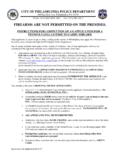
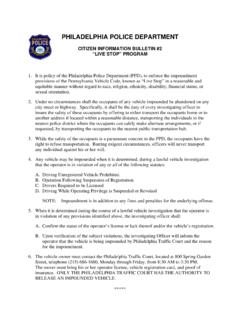

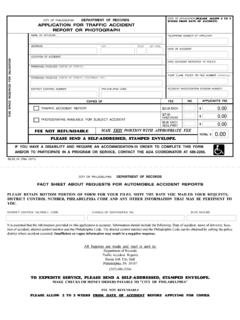
![[PSA] Philly: Classaction lawsuit brings changes in …](/cache/preview/1/4/c/8/8/d/5/c/thumb-14c88d5c5b2f1fee5e561fc7daceb397.jpg)
